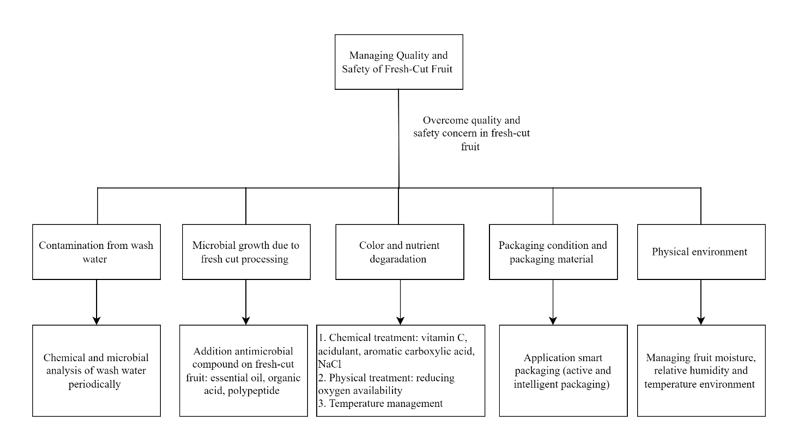Quality in Fresh-cut Fruits: Approach to Reduce Food Waste and Food Loss
How do you manage quality fresh-cut fruits?
Quality management in fresh-cut fruit is challenging, especially when considering the entire supply chain involved in fruit production. The International Fresh-cut Produce Association defines fresh-cut products as fruits or vegetables that have been trimmed, peeled, and cut into a 100% usable product that is prepackaged to offer consumers high nutrition, convenience, and flavor while maintaining its freshness.
A comprehensive strategy must be implemented that monitors and controls each supply chain stage to effectively manage fruit freshness. Defining fruit quality can be done by considering consumer preference as a reference, emphasizing consumption quality over purchase quality attributes such as size and color.
Procedures to maintain fruit quality must be applied, such as evaluating the product for the presence or absence of defects, determining the tolerance level for each type of defect, and determining the percentage of fruit with each defect class during quality evaluation as a guide to overall product quality.
Grading and scoring usage based on a categorizing system will be an effective and efficient way to maintain the quality of fresh fruit. Implementing this system properly can also help reduce food waste and food loss resulting from post-harvest losses.
What are the essential considerations while fresh-cut fruits are being prepared?
Fresh fruit quality evaluation by scoring and grading is the first stage to producing excellent-quality fresh-cut fruit. The next stage is to establish operational standards to maintain the quality and safety of fresh fruit while it is being prepared as fresh-cut fruit. This is crucial to ensuring consumer safety when consuming fresh-cut fruit. Important things that need to be considered when preparing fresh-cut fruit include:
- The raw materials for preparing fresh-cut products should be of good quality.
- Excess moisture should be gently removed or drained.
- Appropriate temperature control should be applied at every stage, including processing, storage, distribution, and handling.
- Strict hygiene and good manufacturing practices.
- Careful cleaning and/or washing should be done before and after peeling.
- Sharp knives on cutters should be used to minimize physical or mechanical damage during fresh-cut processing operations such as peeling, cutting, slicing, and/or shredding.
- Mild processing aids in washing water for disinfection or the prevention of browning and texture loss should be used.
- Appropriate packaging material and packaging methods.
How does the cutting process affect the quality and safety of fresh-cut fruit?
The cutting process in fresh-cut fruit production is a critical parameter and the most important step to defining the quality and safety of fresh-cut fruit products. Evaluation and understanding of detailed processes and chemical and physiological reactions during cutting fresh fruit is an effective and efficient way to find solutions to degradation quality during processing. The physiological and chemical reactions below impact quality and safety during the cutting process:
- The physiology of minimally processed fruit is essentially the physiology of wounded tissues.
- Those processes will increase respiration rate and ethylene production, membrane degradation leading to cellular disruption, decompartmentalization of enzymes and substrates, and accumulation of secondary metabolites.
- Quality attributes, including texture, color, flavor, and nutritional content, are altered by these biochemical processes.
- The intensity of the wound’s response in fresh-cut tissues can be mediated by several physical, chemical, and physiological factors. These factors include genetic background, stage of physiological maturity, temperature, gas composition, light, water vapor pressure, various inhibitors or elicitors, and severity of wounding.
How do you manage the quality and safety of fresh-cut fruits?
Fresh-cut fruits will become more of a high-value specialty item with quality and safety aspects, including total absence of pesticides, visual appearance, and taste-related attributes such as fruit firmness, sugar content, organic acid content, and tissue juiciness. Quality and safety control systems must be applied to ensure fresh-cut fruit is safe for customers to consume. Figure 1 explains step by step how to manage the quality and safety of fresh-cut fruit by a problem-solving approach based on critical parameters in the quality and safety of fresh-cut fruit.
Strategy managing the quality and safety of fresh-cut fruit must consider the concept of value-adding fresh fruit as perishable food. Upgrading the value of fresh fruit by managing and controlling the cutting process is one of the approaches that can be done to reduce food waste and food loss from post-harvest. The selection of packaging materials, technology, and techniques must be suitable to the characteristics and categories of fresh-cut fruit to provide a method that can manage and maintain the quality and safety of the product.

Figure 1. Managing Quality and Safety of Fresh-Cut Fruit.
References:
Kitinoja, L. and Kader, A.A. 2015. Measuring post-harvest losses of fresh fruits and vegetables in developing countries. Postharvest Education Foundation. PEF White paper 15-02. The Postharvest Education Foundation, La Pine. 26pp
Bancal, V and Ray, R.C. 2022. Overview of Food Loss and Waste in Fruits and Vegetables: From Issue to Resources: Fruits and Vegetable Wastes. Springer, Singapore.
Florkowski, W.J., Banks, R.L., Shewfelt, R.L. and Prussia, S.E. 2022. Postharvest Handling: A Systems Approach. Academic Press, London.
Goyal, M.R and Ahmad, F. 2023. Quality Control in Fruit and Vegetable Processing: Method and Strategies. CRC Press, USA.
Siddiqui, M, W. 2020. Fresh-cut Fruits and Vegetables: Technologies and Mechanisms for Safety Control. Academic Press, UK.
Further reading
Quality Standardization of Fresh Fruit and Vegetables to Reduce Food Waste and Loss










































































